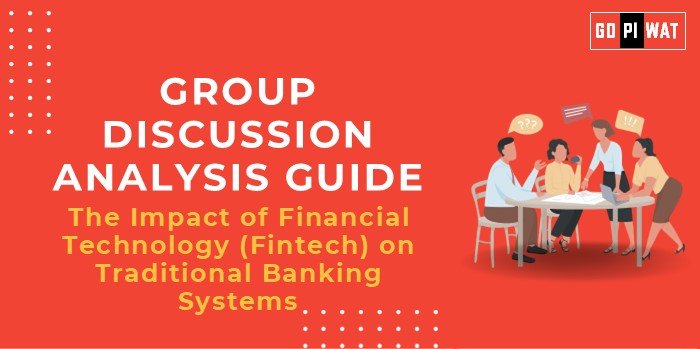📋 Group Discussion (GD) Analysis Guide
🌐 Topic: The Impact of Financial Technology (Fintech) on Traditional Banking Systems
🌟 Introduction to the Topic
Opening Context: Fintech, a transformative force in the financial world, has reshaped traditional banking systems, bringing efficiency, accessibility, and innovation. Its impact spans developed and emerging markets, with significant implications for global and local economies.
Topic Background: Fintech emerged prominently in the last two decades, leveraging technology to provide financial services. Traditional banks now face both opportunities for partnerships and challenges to their dominance due to fintech’s rapid evolution.
📊 Quick Facts and Key Statistics
- Global Fintech Market Size: Expected to reach $698.48 billion by 2030, growing at a CAGR of 20.3% (Grand View Research, 2023).
- Bank Collaboration Rate: Over 75% of traditional banks partnered with fintech firms in 2022 to enhance digital offerings (Deloitte, 2023).
- Customer Preferences: 60% of millennials prefer fintech apps over traditional banking services (Capgemini, 2023).
- Unbanked Population Impact: Fintech reduced the global unbanked population by 30% in the past decade, with mobile payment systems leading the charge (World Bank, 2023).
👥 Stakeholders and Their Roles
- Traditional Banks: Adapt through digitization, partnerships, and new product lines.
- Fintech Firms: Drive innovation, offering services like mobile banking, P2P lending, and blockchain.
- Governments and Regulators: Set frameworks to ensure stability while fostering innovation.
- Customers: Push demand for convenience, transparency, and personalized services.
🏆 Achievements and Challenges
🎯 Achievements
- Enhanced Financial Inclusion: Mobile banking platforms reduced the unbanked population by millions.
- Increased Efficiency: Digital lending and AI-powered risk assessment streamlined operations.
- Customer Experience: Personalization through AI and big data transformed user engagement.
- Partnership Success: Collaborations, like JPMorgan and OnDeck, illustrate synergistic value.
⚠️ Challenges
- Regulatory Uncertainty: Balancing innovation and consumer protection.
- Cybersecurity Threats: Increased cyber-attacks on digital platforms.
- Bank-Fintech Competition: Struggles in managing competitive dynamics, especially for small banks.
🌍 Global Comparisons
- China: Leads in mobile payments with platforms like Alipay and WeChat Pay.
- Europe: Open banking initiatives showcase successful collaboration frameworks.
📚 Case Study: India’s UPI
Demonstrates fintech’s potential to integrate with traditional banking, achieving 11.5 billion monthly transactions by 2024.
🔑 Structured Arguments for Discussion
- Supporting Stance: “Fintech drives unprecedented access to financial services, empowering underbanked regions globally.”
- Opposing Stance: “Fintech’s rise challenges regulatory frameworks and the security of customer data.”
- Balanced Perspective: “While fintech revolutionizes access and convenience, its long-term sustainability depends on robust regulation and partnerships.”
📈 SWOT Analysis
- Strengths: Innovation, inclusivity, partnerships.
- Weaknesses: Cybersecurity vulnerabilities, regulatory hurdles.
- Opportunities: AI integration, cross-border payments.
- Threats: Rising competition, privacy concerns.
🎓 Connecting with B-School Applications
- Real-World Applications: Topics for B-school projects include AI in fintech and the role of blockchain.
- Sample Interview Questions:
- “How should traditional banks leverage fintech for growth?”
- “What role do regulatory frameworks play in the fintech ecosystem?”
- Insights for Students: Explore opportunities in fintech startups or consulting for banks transitioning to digital.


